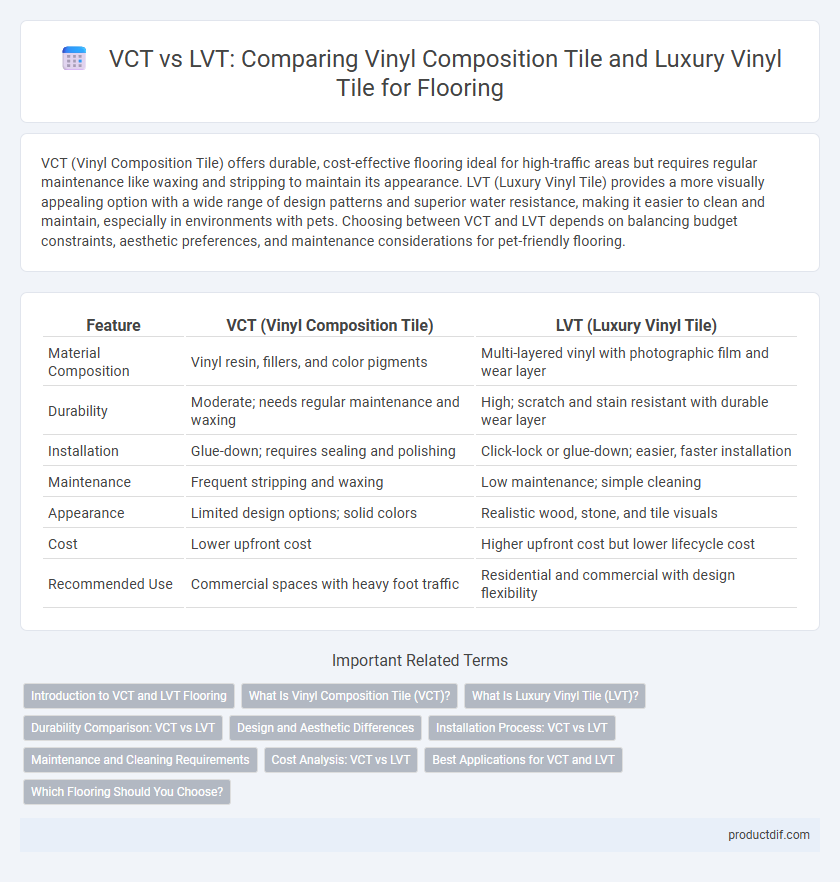VCT (Vinyl Composition Tile) offers durable, cost-effective flooring ideal for high-traffic areas but requires regular maintenance like waxing and stripping to maintain its appearance. LVT (Luxury Vinyl Tile) provides a more visually appealing option with a wide range of design patterns and superior water resistance, making it easier to clean and maintain, especially in environments with pets. Choosing between VCT and LVT depends on balancing budget constraints, aesthetic preferences, and maintenance considerations for pet-friendly flooring.
Table of Comparison
| Feature | VCT (Vinyl Composition Tile) | LVT (Luxury Vinyl Tile) |
|---|---|---|
| Material Composition | Vinyl resin, fillers, and color pigments | Multi-layered vinyl with photographic film and wear layer |
| Durability | Moderate; needs regular maintenance and waxing | High; scratch and stain resistant with durable wear layer |
| Installation | Glue-down; requires sealing and polishing | Click-lock or glue-down; easier, faster installation |
| Maintenance | Frequent stripping and waxing | Low maintenance; simple cleaning |
| Appearance | Limited design options; solid colors | Realistic wood, stone, and tile visuals |
| Cost | Lower upfront cost | Higher upfront cost but lower lifecycle cost |
| Recommended Use | Commercial spaces with heavy foot traffic | Residential and commercial with design flexibility |
Introduction to VCT and LVT Flooring
Vinyl Composition Tile (VCT) consists of colored vinyl chips formed into solid sheets, offering a durable and cost-effective flooring solution commonly used in commercial spaces. Luxury Vinyl Tile (LVT) features a multi-layer construction with a photographic layer that realistically mimics natural materials like wood or stone, providing enhanced aesthetic appeal and versatility. Both VCT and LVT flooring provide moisture resistance and ease of maintenance, but LVT delivers superior design options and comfort underfoot, making it ideal for residential and higher-end commercial installations.
What Is Vinyl Composition Tile (VCT)?
Vinyl Composition Tile (VCT) is a durable flooring material composed primarily of natural limestone, fillers, thermoplastic binders, and color pigments, offering a hard and resilient surface ideal for high-traffic commercial spaces. VCT is known for its cost-effectiveness, ease of maintenance, and ability to withstand heavy wear, making it a popular choice in schools, hospitals, and retail environments. Unlike Luxury Vinyl Tile (LVT), VCT requires regular waxing and polishing to maintain its appearance, which can result in higher long-term maintenance efforts.
What Is Luxury Vinyl Tile (LVT)?
Luxury Vinyl Tile (LVT) is a high-performance flooring material that mimics the appearance of natural wood, stone, or ceramic with enhanced durability and water resistance. Composed of multiple layers including a protective wear layer, printed design layer, and a resilient core, LVT offers superior comfort and sound absorption compared to Vinyl Composition Tile (VCT). Ideal for both residential and commercial spaces, LVT requires minimal maintenance while delivering excellent resistance to scratches, stains, and moisture.
Durability Comparison: VCT vs LVT
Luxury Vinyl Tile (LVT) offers superior durability compared to Vinyl Composition Tile (VCT) due to its multi-layer construction, which provides enhanced resistance to scratches, stains, and wear. VCT requires regular maintenance and periodic waxing to maintain its appearance, whereas LVT typically resists moisture and heavy foot traffic with minimal upkeep. This makes LVT a preferred choice for commercial spaces demanding long-lasting, low-maintenance flooring solutions.
Design and Aesthetic Differences
VCT (Vinyl Composition Tile) offers a more traditional, factory-applied coloring with limited design options, often featuring solid colors or simple patterns suitable for commercial settings. LVT (Luxury Vinyl Tile) provides a superior aesthetic range, replicating natural materials like wood, stone, and ceramic through advanced printing technology and realistic textures. The design versatility of LVT allows for intricate patterns and customizable layouts, making it preferred for high-end residential and retail spaces seeking both style and functionality.
Installation Process: VCT vs LVT
VCT (Vinyl Composition Tile) requires a more labor-intensive installation process involving multiple steps such as subfloor preparation, adhesive application, and periodic waxing to maintain durability. In contrast, LVT (Luxury Vinyl Tile) offers a simpler installation with options like click-lock systems or adhesive-backed planks, reducing time and skill levels needed. LVT's floating floor installation is ideal for quick renovations, while VCT demands professional expertise for long-term commercial use.
Maintenance and Cleaning Requirements
Vinyl Composition Tile (VCT) requires regular stripping, waxing, and buffing to maintain its appearance, making maintenance labor-intensive and time-consuming. Luxury Vinyl Tile (LVT) offers easier cleaning with simple sweeping and mopping, requiring no waxing or sealing, which reduces overall upkeep efforts. Both materials resist stains and moisture, but LVT's durability and low maintenance make it ideal for high-traffic areas seeking long-term cost savings.
Cost Analysis: VCT vs LVT
Vinyl Composition Tile (VCT) generally costs less upfront, averaging $2 to $5 per square foot, making it a budget-friendly option for large commercial spaces. Luxury Vinyl Tile (LVT), priced between $3 and $7 per square foot, offers higher durability and design versatility, which can reduce long-term maintenance and replacement expenses. When considering total cost of ownership, LVT's resilience to wear and moisture often results in better value despite its higher initial price.
Best Applications for VCT and LVT
VCT (Vinyl Composition Tile) is best suited for high-traffic commercial spaces such as schools, hospitals, and retail stores due to its durability, easy maintenance, and cost-effectiveness. LVT (Luxury Vinyl Tile) excels in residential and upscale commercial environments where aesthetic appeal and realistic wood or stone looks are prioritized, offering superior water resistance and comfort underfoot. Both materials provide versatile flooring solutions but differ significantly in installation complexity and long-term performance in specific applications.
Which Flooring Should You Choose?
VCT (Vinyl Composition Tile) offers durability and cost-effectiveness, making it ideal for high-traffic commercial spaces, while LVT (Luxury Vinyl Tile) provides superior aesthetics, water resistance, and comfort, perfect for residential and retail settings. LVT's advanced wear layers and realistic designs outperform VCT in longevity and visual appeal, though it comes at a higher price point. Choosing between VCT and LVT depends on budget constraints, desired style, and application environment.
VCT vs LVT (Vinyl Composition Tile vs Luxury Vinyl Tile) Infographic

 productdif.com
productdif.com